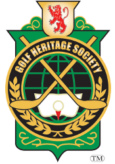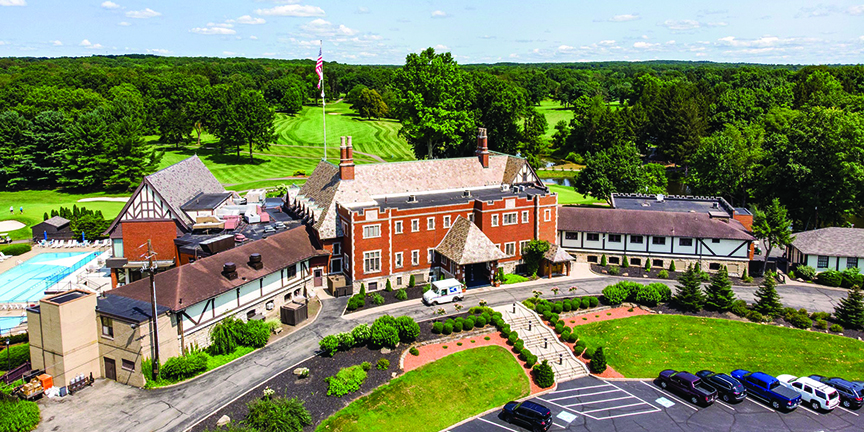
Originally published in the Summer 2024 edition of The Golf.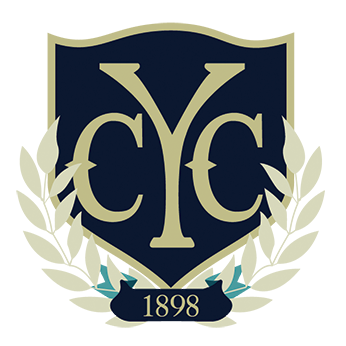
By David Moore
Since its inception in 1898, the Youngstown Country Club in Ohio has been a pillar of the community and a gathering ground for the region’s titans of industry. The club itself was started as the Mahoning Golf Club by a group of 80 men and women who each subscribed for five dollars. The leader of the group, and the one thought to have brought golf to Youngstown, was William F. Bonnell, a steel magnate with ties to Pittsburgh’s Jones & Laughlin Steel Company and the local Mahoning Valley Iron Company. While not confirmed, it is believed that Bonnell either learned the game while traveling abroad in Scotland or at one of the early local links in Foxburg, Pa., or the fabled Oakhurst Links in West Virginia.
Regardless of his origins in the game, Bonnell was elected president to lead the Mahoning Golf Club in 1898. The group leased a 55-acre parcel of land on the outskirts of the city known as Bissell Farm, which today sits on the edge of Wick Park. Here, golf planted its roots in the city of Youngstown.
The original nine-hole course was designed by W.H. Way, who originally designed the Euclid Club, Detroit Golf Club and Mayfield Country Club. His brother, Jack, would become the club’s first professional once the course opened for play. The property proved perfect for golf, featuring undulating land, a treacherous ravine and a group of trees that provided plenty of natural hazards.
The original clubhouse was designed by member John Tod. The grandson of former Ohio Governor David Tod, John proved to be one of the key members and leaders of the club in the first quarter-century of its existence. A future club president, Tod’s clubhouse was completed for $1,600 and was heralded for its beautiful stone fireplace, electric lighting, and a line into the city’s water system. While the club has long abandoned this original clubhouse, the building still stands to this day as a private residence.
As mentioned in the opening, the club served as the playground for all of the Youngstown titans of industry. One of the most prominent was Geoge D. Wick. Along with fellow member James A. Campbell, Wick was the founding president of Youngstown Sheet and Tube Company, one of the nation’s largest steel manufacturing firms. Tragically, Wick was among the 1,500 individuals who lost their lives in the sinking of the RMS Titanic in April 1912. Another was Henry H. Stambaugh, who made his fortunes in coal and iron. Today, the city’s auditorium is named in Stambaugh’s honor, as is a municipal golf course.
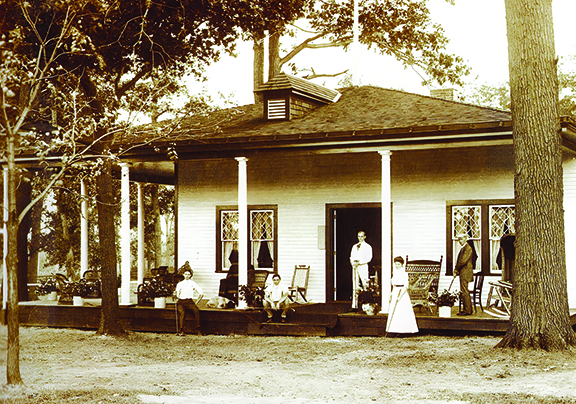
The original property at Bissell Farm proved to be too small within the first decade of the club’s history. By 1905, it moved further out from the encroaching city, to a property that allowed for a 2,950-yard, nine-hole golf course and a more elaborate clubhouse that featured locker rooms, a reception area, dining rooms and even servants quarters.
The move also allowed for the club to host its first state championship, the 1907 Ohio Amateur. Ninety-three golfers entered the tournament, including 16 members of the club. 1 In the end, Inverness member Harold Weber claimed the title. While the reception of the course was favorable, one final move was in the works for the club.
In July 1909, the Mahoning Golf Club moved for the final time to the club’s present location. It also reincorporated as the Youngstown Country Club, with the property allowing more sporting opportunities, such as skeet shooting and tennis. The new 121-acre property was purchased for $18,000 (roughly $618,000 in 2024). 2 John Tod once again held the task of organizing the construction of the new clubhouse.
As for the design of the golf course at the new home of the Youngstown Country Club, the task would fall to three-time U.S. Amateur champion Walter Travis. The new 18-hole design (1911) brought the Ohio Amateur back to YCC in 1915. Once again, an Inverness member, Holland Hubbard, claimed the title, defeating Youngstown’s own Bud Medbury in the finals. The Ohio Open also came to YCC in 1922, with the club’s professional, Emmett French, winning the title.
A little over a decade after Travis completed the course, the club brought in Donald Ross to lead a renovation project. Ross’ work focused on reconstructing the green complexes, as well as lengthening the golf course. The renovated course opened for play in 1924 and was showcased for the nation the following year with the hosting of the Western Open Championship.
To date, the 1925 Western Open is the biggest event to be played on the Club’s fairways. The event featured many of the game’s biggest stars, including Walter Hagen, Gene Sarazen, Johnny Farrell and Tommy Armour. In the end, Macdonald Smith won his second of three career Western Opens, tying the tournament scoring record (281) in the process.
Like most of the great clubs across the country, Youngstown Country Club was home to fantastic amateur players. One was Christopher “Christy” Deibel. Born in 1874, Deibel became a tailor before going into the theater business with his brother-in-law. 3 He took up golf in his early 30s, and eventually won 16 Club Championships, including nine in a row from 1914 to 1922. While he never won an Ohio Amateur, he did win the 1935 United States Senior Golf Championship at Apawamis Club over former U.S. Amateur champion Findlay S. Douglas.
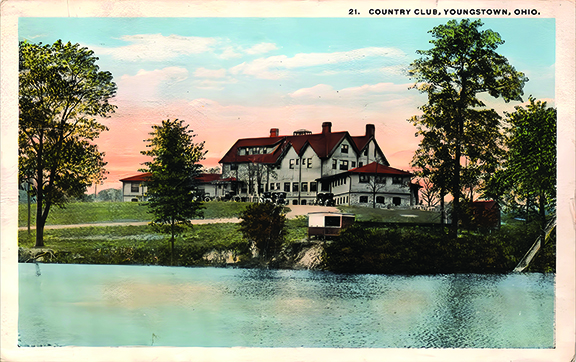
Another star of the Youngstown links was Louise Fordyce. A 10-time club champion, Fordyce was a national star and counted among the best women’s amateur players in the 1920s. She claimed four Ohio Women’s Amateur titles in five years, including the 1924 tournament at YCC. In 1925, she reached the semifinals of the U.S. Women’s Amateur at St. Louis Country Club (losing to Alexa Sterling) and a year later won the North and South Women’s Amateur at Pinehurst. She was also a member of the first unofficial Curtis Cup team in 1930, winning her singles match over former British Ladies Amateur champion Doris Chambers. 4
Unfortunately, tragedy struck the club on May 3, 1928, when the clubhouse caught fire. Likely caused by faulty wiring in the basement, the center portion of the clubhouse burned, but after several hours of fighting, the fire company was able to salvage the east and west wings. 5 Once again, John Tod took the lead in rebuilding the facilities.
As time marched on, the club continued to host big tournaments. The Ohio Amateur came back for the final time to date in 1928 with William Deuschle winning. In 1938, the Ohio Open returned with 1931 U.S. Open champion Billy Burke taking the title. In June 1945, the club hosted the Youngstown Open, which served as a tribute to Sergeant Andy Alcroft, a local pro and son of YCC’s professional Albert Alcroft, who was killed in action in World War II. 6 Despite cold, rainy weather, Billy Burke once again conquered the course, winning by a shot over 3-time major champion Denny Shute. Finally, the 1976 Ohio Women’s Amateur returned to Youngstown, with Gail Clayton claiming the title.
The lineage of professionals at Youngstown Country Club is also a great source of pride to the membership. After Jack Way, Arthur Boggs took the professional reins before James Maiden arrived. Maiden was the brother of Stuart Maiden, the professional at East Lake Golf Club in Atlanta who taught Bobby Jones and Alexa Sterling. He was eventually replaced by Bert Lagerblade.
In 1921, assistant Emmett French took over for Lagerblade. Over the next five seasons, French became among the best professionals in the country. He won the 1922 Ohio Open and finished runner-up at the 1922 PGA Championship at Oakmont. He followed that by winning the 1924 Ohio Open, as well as the 1924 Pennsylvania Open at Oakmont. He also served as the American captain of the first unofficial Ryder Cup team in 1921.
French retired after the 1925 season, but continued serving as a professional in Southern Pines, N.C. He was replaced by Albert Alcroft, who stayed at the club for nearly two decades. Edward Griffith replaced Alcroft, followed swiftly by Ted Luther. In 1963, Bill Cox became the club’s professional. Cox apprenticed under Lew Worsham at Oakmont before serving the Youngstown membership for over 35 years. Following Cox’s retirement in 2000, Scott Sundstrom, another Oakmont alum, took over the position and remains in the role to this day.
In the 1970s, YCC began an association with architect Geoffrey Cornish to make improvements to the course. Cornish got his start under Stanley Thompson prior to serving in World War II. Based in Massachusetts, he is credited with over 200 designs, including International Golf Club which hosted an LIV Golf event in 2022. He served as American Society of Golf Course Architects (ASGCA) president in the 1970s and co-authored The Architects of Golf in 1982. His improvements to the Youngstown course can still be seen today.
Today, the Youngstown Country Club remains a pillar of the community. In 2023, the club celebrated its 125th anniversary, and just this spring it was placed on the National Register of Historic Places by the Department of the Interior. The Youngstown Country Club is proud to be one of the first “Heritage Clubs” of the Golf Heritage Society.
Colonel John Morley
The man who put the Youngstown Country Club on the national map was not a player or even one of the club’s professionals, but greenkeeper Colonel John Morley. Bornin Middlesboro, England in 1866, he immigrated with his parents in the early 1870s. Before serving the Youngstown Country Club as greenkeeper, he worked as a hotel manager in town.
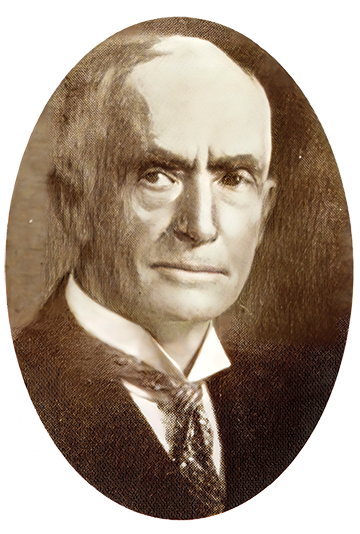
Morley took control of the club’s greens in 1913 and remained with them for 30 years. During his tenure, he revolutionized the role of greenkeeper, subsequently creating the Northern Ohio Golf Course Superintendent Association in 1923 and the Golf Course Superintendent Association of America (GCSAA) in 1926. His contributions to the profession led to his being awarded a special prize by the GCSAA in 1940, and posthumously its Old Tom Morris Award in 2009. Today, the GCSAA gives its top annual award in Morley’s honor.
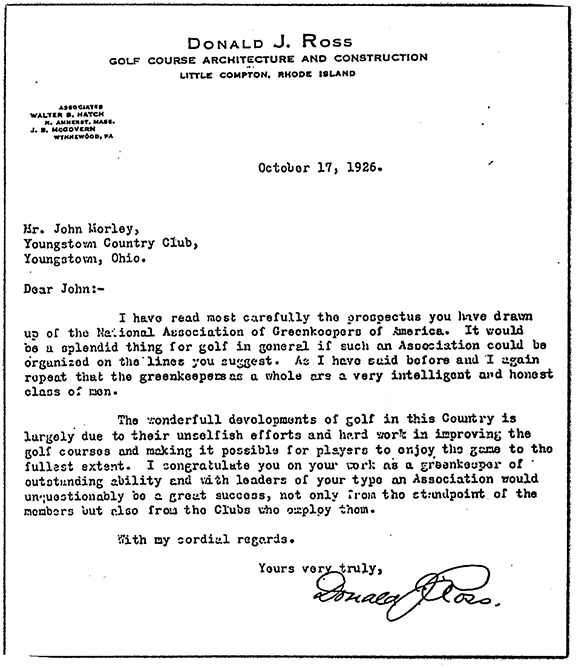
Home of “Roaring” Exhibitions
The “Roaring 20s” brought a plethora of world class exhibition matches to the links of the Youngstown Country Club. The first such exhibition took place on Aug. 5, 1920, when seven-time major champion Harry Vardon returned alongside Ted Ray for one last American tour. The Jerseymen played Bert Lagerblade and Emmett French. The match was halved, with the Youngstown duo claiming the first 18 holes 1-up, while Vardon and Ray won the afternoon 18 by the same margin. The following week, Ray won the U.S. Open at Inverness. Vardon finished runner-up.
Two years later, the swashbuckling Walter Hagen embarked on a tour across the United States alongside Australian trick-shot artist Joe Kirkwood. The pair played Emmett French and former U.S. Amateur champion William C. Fownes Jr. Hagen established the course record (66) en route to defeating French and Fownes 3&1.
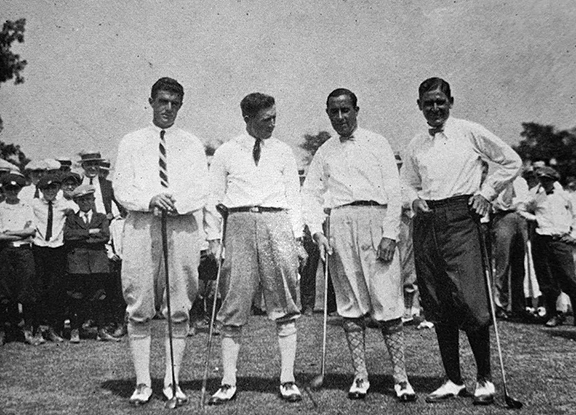
Hagen and Kirkwood returned the following year, this time facing French and two-time major champion Jock Hutchison, with a $50 prize offered to the pro who shot the lowest score. Though Hagen and Kirkwood won the match, French took the $50 prize by shooting 140 over 36 holes.
Following the Western Open in 1925, exhibitions returned to YCC. In 1927, reigning U.S. Open champion Tommy Armour came to town alongside Johnny Farrell, the professional from Quaker Ridge. While Armour was the Open champion, Farrell was on a hot streak, having won seven straight events including the Shawnee, Metropolitan and Pennsylvania Opens. They defeated the club’s professional Albert Alcroft and Mahoning Valley Country Club pro Tommy Rackletts 2-up.
Johnny Farrell returned in 1928 for another exhibition, fresh off his own U.S. Open victory at Olympia Fields. He partnered with Gene Sarazen, then a three-time major champion. They faced Alcroft and Larry Nabholtz, a local professional from nearby Sharon, Pa. Alcroft atoned for his loss the previous year at Farrell’s hands, as he and Nabholtz won the match 2-up.
Footnotes
1 Gurley, Joseph. “The Youngstown Country Club: 100 Years of Golfing and Assorted History.” 1998.
2 Ibid, Gurley.
3 “C.W. Deibel Dies at 96; Golf Star.” Youngstown Vindicator. December 17, 1970.
4 “American Women Golfers Lose to British.” Pittsburgh Post-Gazette. May 2, 1930.
5 Ibid, Gurley
6 “Denny Shute Among Entries in Youngstown Open June 4.” Akron Beacon Journal. June 1, 1945.
